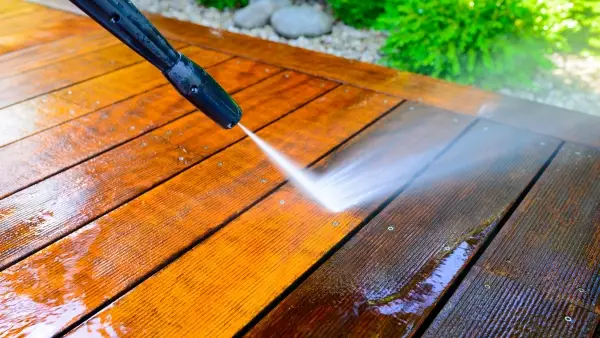
Has your wood deck or wood fence become gray, dingy, and weathered over the years? Have you thought that replacing the wood was the only answer? Do you avoid outdoor entertaining because you are embarrassed by how bad it looks? If the answer to any of these questions is yes, Window Genie has the solution that can save you time, money, and a lot of aggravation. We’ve answered a few of our most common questions regarding deck cleaning and sealing:
Can I use bleach to clean my wood deck?
Window Genie never uses bleach on a deck and we recommend you don’t either. Bleach does a good job of killing mildew but does nothing against dirt. Think about what you use when you do your laundry; you may use bleach as a whitening agent, but you still use a detergent to clean your clothes.
Bleach is used by paper manufacturers to break down lignin, which is the natural component that holds wood fibers together. Excessive bleach will do the same thing to a deck. If this happens to your deck the wood fibers will appear loose. With continued use, you will actually be able to tear the wood with a gentle push of your fingernail. In addition, when used in strong enough concentrations, bleach can actually corrode iron nails, nuts, and bolts that may be holding your deck together. Not safe!
When buying a commercial deck cleaner, check the labels for sodium hypochlorite or calcium hypochlorite. These ingredients are just technical terms for bleach and will do the same damage as the bleach you buy in the supermarket. Don’t be fooled by claims of “buffered bleach” either. Even with fancy names, bleach is still bleach, and it is always damaging.
Can I pressure wash the deck myself?
There are several low-powered pressure washers marketed directly to homeowners. A pressure washer is not difficult to operate. However, it is very easy for an untrained individual to damage the wood with too much pressure. If you have never used a pressure washer before, experiment on a few old pieces of wood first. If you have a second-story deck, you may be able to practice on the non-visible underneath portion. If you are also using a chemical cleaner, you will be able to clean the deck at a lower pressure. The pounds per square inch of water pressure (PSI) typically used in cleaning decks ranges from 300 to 3,000. Window Genie uses an average of 1500 – 2000 PSI, depending on the condition of the wood. Cedar and redwood demand much less pressure.
If you are buying a pressure washer aimed at home use, your only option will likely be cold water. That’s okay. Window Genie uses and recommends cold water for wood surfaces. Heat causes wood to expand and this results in an over-absorption of water that is damaging for the wood. Hot water pressure cleaning on wood is only suitable in situations where there are heavy grease stains or sealant to remove. If that’s the case, you should call a professional. Hot water pressure washing requires a trained professional.
Why does my wood appear fuzzy after pressure washing it?
Pressure washing removes the outer layer of dead wood, and can sometimes make it look like it has short fuzzy hairs. This is caused by the tearing of the wood fibers. This is normal and does not indicate damage. These fuzzies will generally go away in 2 or 3 weeks. It is okay to apply sealer over fuzzies.
Fuzzies can also be removed with a light sanding. Depending on the extent of damage, a kitchen scrubber or pool brush may be all you need to blend in the damage. If the fuzzies are deep and more extensive you may wish to use sandpaper or bronze wool. We recommend using bronze wool as opposed to steel wool because it will not leave a rust spot. If you scrub your wood deck with steel wool, tiny steel particles will be left behind. They may not even be visible. However, the small particles will remain in the wood, and with rain they will begin to oxide and the result will be rust spots.
How do I clean a previously sealed deck?
Your entire deck should be cleaned once a year after sealing. Spot cleaning should be done as necessary, whenever something oily is spilled on your deck, such as a dropped hamburger. Scrub your deck with a solution of regular liquid dishwashing soap and warm water. Use a medium bristle, nylon scrub brush that will not dig into the wood too much. Rinse with plenty of water until no suds remain. Unless you have some problem spots that were left untreated for long periods of time, this cleaning method should suffice. If you have extensive staining, algae or mold on your deck, a stronger cleaner will be necessary. From your local hardware store or Home Depot, purchase a liquid deck cleaner and brightener. This will be more aggressive than soap and water, but it will not remove the existing sealer. The product is safe and easy to use, just follow the instructions.
How do I re-seal my deck?
When it’s time to reseal your deck, it is very important that all previous sealer is removed before a new sealer is applied. This is true even if you are using the same brand of sealer. Sealer works by being absorbed into the wood. If any old sealer remains, there will be interference with the absorption. Sodium hydroxide-based strippers will remove most old sealants. Be sure to follow product directions carefully. Softwoods such as cedar and pine are most susceptible to chemical damage from strippers.
Some brands of sealer are more difficult to remove than others. In our experience, Behr is one of the most difficult sealers to remove. It may be necessary to do at least two cleanings before all the old sealer is removed.
